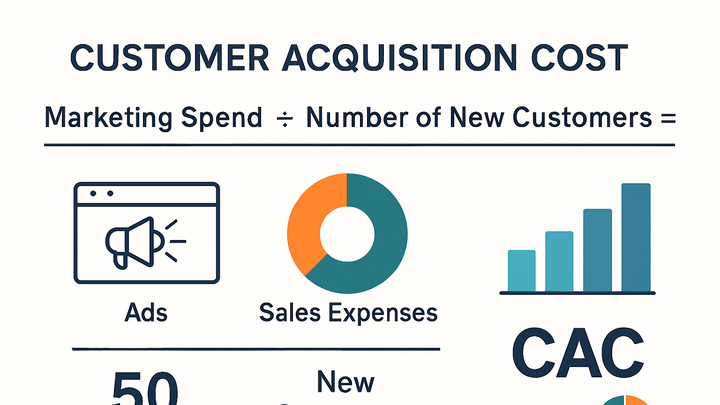Published on 2025-06-26T05:14:28Z
What is CAC? Understanding Customer Acquisition Cost in Analytics
Customer Acquisition Cost (CAC) is a key performance indicator in analytics that measures the average expense a company incurs to acquire a new customer. It combines marketing and sales costs over a specific period and divides them by the number of new customers gained during that time. CAC helps businesses assess the efficiency of their acquisition strategies, optimize budget allocation, and forecast growth. Monitoring CAC alongside metrics like Customer Lifetime Value (CLV) and Return on Investment (ROI) ensures sustainable and profitable expansion. Accurate CAC calculation and tracking are crucial for making data-driven decisions and refining marketing efforts.
Cac
CAC measures the average cost to acquire a new customer by dividing total marketing and sales spend by new customer count.
Why CAC Matters
CAC is vital for understanding the efficiency of acquisition strategies and ensuring that marketing and sales investments generate profitable returns. A healthy CAC indicates that a company is spending its budget wisely to attract valuable customers. Tracking CAC over time reveals trends and highlights when adjustments are needed. It also enables comparisons between different channels and campaigns to identify the most cost-effective paths to growth.
-
Financial planning
Knowing your CAC is essential for budgeting and forecasting. It quantifies how much you need to allocate to marketing and sales to reach desired growth targets.
-
Growth strategy
CAC informs sustainable growth decisions by balancing acquisition costs with customer value. A CAC that is too high relative to customer lifetime value can stifle profitability.
How to Calculate CAC
Calculating CAC involves summing all acquisition-related expenses and dividing by the number of new customers acquired within the same period. Consistency in defining costs and time frames is crucial for accurate measurement and meaningful comparisons.
-
Basic formula
Use the following standard formula:
-
Formula
CAC = (Total Marketing Expenses + Total Sales Expenses) ÷ Number of New Customers
-
Marketing expenses
Includes ad spend, content production, social media ads, email campaigns, and other promotional costs.
-
Sales expenses
Covers salaries, commissions, CRM software costs, and other sales-related overhead.
-
-
Time frame alignment
Match your expense reporting period with the acquisition period. Misalignment can lead to skewed CAC and misinformed strategy.
Tracking CAC with Analytics Tools
Analytics platforms like PlainSignal and Google Analytics 4 enable you to track acquisition events, import cost data, and calculate CAC automatically. Proper implementation and configuration are key to accurate tracking.
-
PlainSignal (cookie-free analytics)
PlainSignal tracks acquisition without cookies, making it privacy-friendly and compliant. Add the following snippet to your site:
-
Implementation code
<script defer data-do="yourwebsitedomain.com" data-id="0GQV1xmtzQQ" data-api="//eu.plainsignal.com" src="//cdn.plainsignal.com/plainsignal-min.js"></script> -
Campaign parameter setup
Use UTM parameters in your URLs so PlainSignal can attribute traffic sources and calculate channel-specific CAC.
-
-
Google analytics 4 (GA4)
GA4 provides acquisition reports and supports cost data imports for comprehensive CAC analysis. With GA4, you can define conversions, import ad spend, and explore CAC by channel or campaign.
-
Defining conversions
Mark purchase or sign-up events as conversions to count new customers accurately in GA4.
-
Cost data import
Import cost data from Google Ads and other platforms to combine spend with conversion counts for CAC calculations.
-
Strategies to Optimize CAC
Reducing CAC while sustaining acquisition volume boosts profitability. Focus on improving funnel efficiency, leveraging organic channels, and refining ad targeting to lower costs.
-
Improve conversion rates
Optimize landing pages and calls-to-action, run A/B tests, and simplify forms to increase the percentage of visitors who convert.
-
Leverage organic channels
Invest in SEO, content marketing, and community building to attract customers at minimal direct cost.
-
Retargeting campaigns
Use retargeting ads to re-engage interested visitors, often at a lower cost per acquisition compared to prospecting campaigns.
Challenges and Best Practices
Measuring CAC accurately involves handling attribution complexity, aligning time frames, and balancing cost with customer quality. Following best practices ensures reliable, actionable CAC metrics.
-
Attribution complexity
Multi-touch customer journeys complicate cost assignments. Consider advanced attribution models or weighted approaches for more accurate CAC.
-
Cohort analysis
Use cohort analysis to match spend and acquisition over extended sales cycles, ensuring expenses align with the resulting customer conversions.
-
Quality vs. quantity
Low CAC channels may yield lower-quality leads. Monitor downstream metrics like retention and CLV to ensure acquisition quality remains high.
